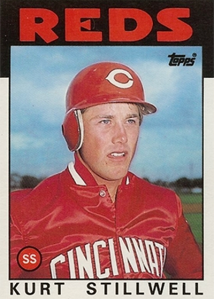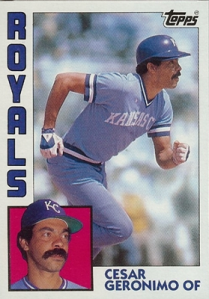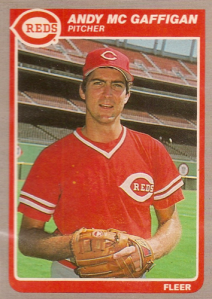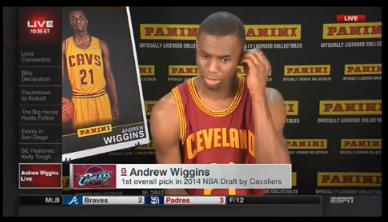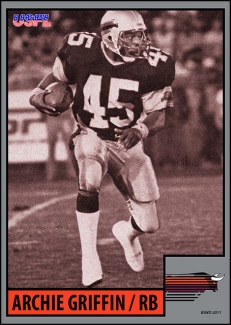Former Reds Friday – Cesar Geronimo 1984 Topps
Known for his defensive prowess, Cesar Geronimo was one of the last members of the Big Red Machine to depart Cincinnati for another team.
Geronimo won four Gold Gloves from 1974-77 as the Reds won back-to-back World Series titles in 1975 and 1976.
However as the Big Red Machine was being disassembled and his offensive production slipped below .240, Geronimo lost his starting job to Dave Collins, according to the Associated Press. He was relegated to the role of a defensive replacement and appeared in only 103 games and 162 plate appearances.
Geronimo was dropped from the Reds 40 man roster following the 1980 season after the signing of free agent of Larry Bittner.
The Reds eventually shipped him to the Kansas City Royals for minor league outfielder German Barranca.
During three seasons with the Royals, Geronimo came off the bench as the team’s fifth outfielder and didn’t appear in more than 59 games per season, according the 1983 Topps Blog.
His stint in Kansas City did allow Geronimo to escape the Reds’ no facial policy and he responded with one thick mustache.
Geronimo was released by the Royals after the 1983 season, which ended up being 15th and final Major League campaign.
Interestingly, Geronimo’s 1984 Topps card featured above was released after he retired.
After retiring, he worked for the Japanese Hiroshima Carp ball club as a coach at its baseball academy in his native Dominican Republic.
Geronimo was inducted into the Cincinnati Reds Hall of Fame in 2008.
Andy McGaffigan Nearly Traded Into A Palindrome

One of Topps’ infamous airbrush cards. Andy McGaffigan with a moustache and in a Reds jersey. Cincinnati banned facial hair until 1999. Photo courtesy of the Trading Card Database.
Trades are a part of professional sports. Former Cincinnati Reds pitcher Andy McGaffigan was no stranger to being moved from team-to-team, except when he was dealt it occurred in a unique order with some familiar stops along the way.
McGaffigan was traded five times between just four teams. The right hander spent 11 seasons in the majors, although from 1982 to 1990 he might felt he was on some weird marry-go-round.
He broke into the big leagues in 1981 with the New York Yankees, however he didn’t stay with the Bronx Bombers for long. The following March, he was dealt to the San Francisco Giants along with outfielder Ted Wilborn for pitcher Doyle Alexander.
After two seasons in San Fran, the last as a part-time starter, he was dealt to Montreal in March 1984 to complete the trade that sent Al Oliver to the Giants. He didn’t stay in Montreal very long either, on July 26, 1984 he was traded to Cincinnati along with a minor league pitcher for first baseman Dan Driessen.
McGaffigan’s arrival in Cincinnati was delayed because his wife was two weeks overdue with the couple’s first child, according to an interview with the Royal Curve blog. Then-Cincinnati general manager Woody Woodward told his new pitcher to join the team after the birth. The pitcher made it to Cincinnati five days after the trade.
The fourth stop in the big leagues brought McGaffigan to the team that first drafted him in the 36th round of the 1974 amateur draft.
The deal also occurred 20 days before another deal between the Expos and Reds that marked the return of Pete Rose to the Queen City in a new role of player.
During his second season with the Reds organization he played with the AAA Denver Zephyers for more that half the season. He was called up in late July and started 15 games the rest of the season as the Reds went 82-79 and finished in second place in the National League West division.
Despite the late season performance, McGaffigan was not in Cincinnati’s long-term plans and was shipped him back to Montreal along with Dann Bilardello, John Stuper and Jay Tibbs in exchange for starting pitcher Bill Guillickson and catcher Sal Butera.
McGaffigan was finally able to get comfortable in his second stint with Montreal. He spent four seasons with the Expos. That is until they traded him back to San Francisco just three days before the start of the 1990 season for a player to be named later.
The Florida native retired in 1991 after bouncing between the Kansas City Royals and Milwaukee Brewers.
Today McGaffigan is a financial planner in Lakeland, Florida.
Paul Konerko Briefly A Cincinnati Red

1999 Topps Chrome Refractor #24 – Paul Konerko – Courtesy of COMC.com
Paul Konerko wraps up a splendid career this weekend with the Chicago White Sox. However its hard not to image what would have happened if Konerko’s brief stint with the Cincinnati Reds would have lasted much longer.
Konerko came and left Cincinnati in 1998 as a part of then-general manager Jim Bowden’s more infamous trades. The Reds acquired the infielder along with relief pitcher Denny Reyes from the Los Angeles Dodgers in exchange for relief pitcher Jeff Shaw.
That trade ruffled many feathers in the Queen City because Shaw, who was the Reds’ only all-star was traded just days before the mid-summer classic. Shaw actually made his Dodger debut in the all star game. Second baseman Bret Boone was a late addition to the roster to give Cincinnati a representative in the game.
Following the trade, Konerko was sent to the Reds’ AAA affiliate Indianapolis Indians where he appeared in 39 games before being called up in September. Once with the Reds’ he appeared in 26 games and hit .219 with 3 homers in 81 at-bats.
However at the time, the Reds had a crowded infield with Sean Casey at first and Willie Green, Pokey Reese and a young Aaron Boone at third.
Just a little more than four months after the trade, Konerko was on the move again. This time, he was dealt to the Chicago White Sox in exchange for outfielder Mike Cameron.
The trade gave the White Sox a pillar of their franchise for the next 16 seasons and helped propel them to the 2005 World Series championship. While playing with the South Siders, he appeared in more than 2,200 games, hit .281 and more than 432 home runs.
Cameron also had a brief stint in Cincinnati. During the 1999 season, Cameron hit .256 with 21 homers and 66 RBIs in his season with the Reds before he was dealt to Seattle along with Jake Meyer, Antonio Perez and Brett Tomko in exchange for Ken Griffey Jr.
Andrew Wiggins Makes A Uni Cameo in Cleveland
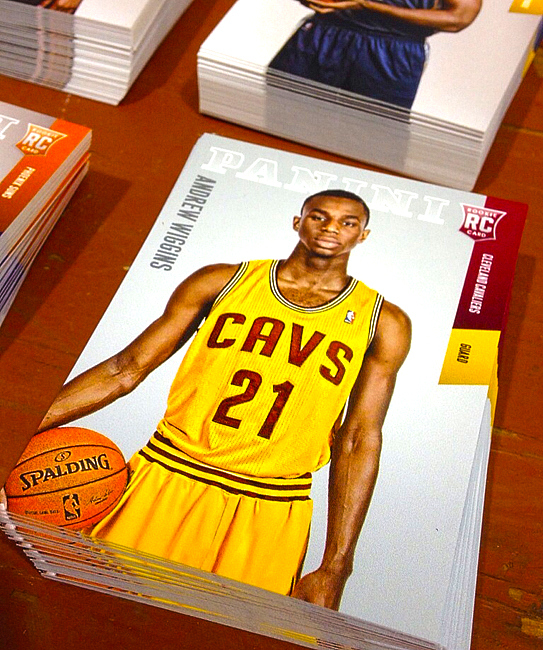
Andrew Wiggins as a Cleveland Cavaliers on the first officially licensed NBA Rookie Cards for the 2014-15 season. Photo: Panini
For a few weeks this summer it appeared that Andrew Wiggins would be one of the key building blocks to help bring the Cleveland Cavaliers back to respectability in the NBA. It turns out we was simply making a uni cameo.
Wiggins is expected to be traded to the Minnesota Timberwolves along with the 2013 top draft pick Anthony Bennett and a 2015 first round draft pick in exchange for Kevin Love.
A uni cameo is a term coined by Paul Lukas of Uni-Watch.
Uni cameos are nothing new for the Cavs. Back in 1987, future all-star Kevin Johnson played part of season in Cleveland before being traded to the Phoenix Suns. Then Shaquille O’Neal suited up for a year near the end of his career in the final year of James’ first stint in Cleveland.
Wiggins’ situation is different than these other Cavs’ uni cameos. He did play in the NBA’s Summer League for Cleveland, however as long as the trade goes through in a few weeks, this uni cameo will be more like Kobe Bryant with the Charlotte Hornets.
Fortunately for Bryant, he did not not to have to go through this awkward ESPN interview. Despite the cringe factor with questions about his future, we get to see another Wiggins rookie card with the Cavs.
Archie Griffin in the USFL
Archie Griffin will always be remembered for his years with Ohio State and some might even remember his NFL days with the Cincinnati Bengals, however his comeback attempt is often forgotten.
Griffin, the only two-time Heisman Trophy winner, signed with the Jacksonville Bulls of the United States Football League (USFL) for the 1985 season, after he was released by the Bengals following the 1983 season.
The Bulls signed Griffin to be the featured back in coach Lindy Infante’s offense, however he was quickly displaced on the depth chart when the Bulls signed another Heisman Trophy winning running back Mike Rozier.
Rozier had opted for the big money the USFL was offering over the NFL and signed a three-year $3 million contract with the Pittsburgh Maulers in 1984 out of college.
At the time, the USFL featured four Heisman Trophy winners. The other two winners Herschel Walker and Doug Flutie both played for the New Jersey Generals.
With the younger Rozier on the roster, Griffin, who was limited to 11 yards rushing on 10 carries and four receptions for 25 yards after just seven games, decided to retired from football.
Perhaps, Griffin would have faired better with the Tampa Bay Bandits for no other reason than the team’s uniforms were a direct copy of Ohio State’s jerseys minus the helment logo.
Ohio Glory brought pro football to The Shoe
 World League of American Football Virtual Football Cards featuring Ohio GLory players Babe Laufenberg (top), Amir Rasul (middle) and Greg Frey (bottom). Cards created by Bill Jones and Willie O’Burke. The Ohio Glory jerseys featured a jersey patch for Amerifloria ’92, an international l horticultural exhibition held in Columbus. |
 |
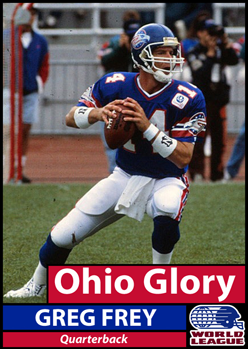 |
Outside of a series of NFL exhibition games between and the Cincinnati Bengals and Cleveland Browns, which were dubbed the Woody Hayes Bowl, professional football did not have a home in Ohio Stadium until 1992.
The Ohio Glory, playing in the second year of the World League of American Football (WLAF), became the first professional football team to call The Shoe home.
The Glory came into existence when the Raleigh–Durham Skyhawks folded after going winless during the 10 game 1991 season. Unfortunately, Ohio only managed to slightly improve on that record with just one win.
The World League, played a spring schedule and was supported by the NFL. The league featured innovations such as helmet radios for quarterback to receive play calls from the sideline, video cameras mounted inside helmets, and the two point conversion.
The league suspended operations following the 1992 season due to financial problems and the inability to obtain further funding from NFL owners. Three years later, the league resurfaced exclusively in Europe and would eventually become known as NFL Europe.
With head coach Larry Little, an offensive guard who was a member of the undefeated 1972 Miami Dolphins, at the helm the Glory’s only win came at Ohio Stadium against one of its international foes. The team defeated the Frankfurt Galaxy 20-17 in week seven.
At the beginning of the season, Ohio’s offense was led by the team’s top draft pick and former NFL quarterback Babe Laufenberg, The former Indiana Hoosier played in the NFL for the Washington Redskins, the New Orleans Saints, the San Diego Chargers, the Dallas Cowboys and the Kansas City Chiefs.
Despite all this experience, his biggest claim to fame was being Troy Aikman’s backup with the Cowboys. During his seven years in the league, he passed for five touchdowns, seven interceptions, including four in a game, and 1,057 yards.
His backups were Pat O’Hara and former Ohio State quarterback Greg Frey.
O’Hara was the team’s leading passer, however he found more success as a cast member of numerous football movies including Any Given Sunday and The Waterboy, according to the World League of American Football fan site. He was also a crew member on The Longest Yard (2005) and We Are Marshall.
Two members of the Glory went on to earn roster spots in the NFL. Punter Tom Rouen played for five teams through the 2005 season.
Linebacker George Koonce immediately become a starter with the Green Bay Packers, which he held for eight seasons.
A gallery of Ohio Glory memorabilia is also available through the World League of American Football fan site.
Troy and Maurice together again in Omaha
 UFL Virtual Football Cards featuring former Ohio State Buckeyes Troy Smith (above) and Maurice Clarett of the Omaha Nighthawks. Cards created by Bill Jones and Willie O’Burke. UFL Virtual Football Cards featuring former Ohio State Buckeyes Troy Smith (above) and Maurice Clarett of the Omaha Nighthawks. Cards created by Bill Jones and Willie O’Burke.
|
 |
When Troy Smith joined the Omaha Nighthawks of the United Football League it signaled a reunion with another former Ohio State Buckeye.
After four seasons in the NFL, the 2006 Heisman Trophy was forced to join the UFL when he was not resigned by the San Fransisco 49ers. The signing opened the door for Smith and running back Maurice Clarett to finally be on the field at the same time.
The two could have been in the same backfield for Ohio State in 2004 if Clarett had avoided NCAA sanctions and played three years in Columbus. That is assuming Clarett’s presence didn’t help the development of Ohio State’s prized blue chip prospect Justin Zwick. Smith took over the starting job six games into the season when Zwick was injured and never game the job back.
Clarett, who helped lead Ohio State to a national championship in 2002, landed in Omaha after four years in prison for a chance to revive his playing career. After his dismissal from the school in 2003, He was a surprise third round selection of the Denver Broncos two years later, however he was cut before the start of the season.
Until being signed by the Nighthawks to be their backup running back behind former Green Bay Packer Ahman Green, Clarett’s only other football options had been talks with the Steubenville Stampede of the American Indoor Football League and the Mahoning Valley Hitmen of the semi-pro Eastern Indoor Football League.
During his first season in Omaha, Clarett rushed for 154 yards on the ground on 37 attempts and a touchdown. He also caught 12 passes for 98 yards, and returned one kickoff for 13 yards during the eight game season.
Smith and Clarett’s reunion did not last very long. The financially troubled UFL suspended operations after just four games. The four team league ended the season by playing a championship game and a consultation game. The latter featured the Sacramento Mountain Lions. Both teams entered the game with a 1-3 record.
Despite having experience in the NFL as starting quarterback with both the Baltimore Ravens and 49ers, Smith was buried on the Nighthawks depth chart behind fellow Heisman Trophy-winner Eric Crouch and Jeremiah Masoli.
It was not until the consultation game, that Smith got his first opportunity to start. He completed 17 of his 33 passes for 191 yards, two touchdowns and one interception in Omaha’s 25-19 loss.
Smith might be on his way back to playing in the NFL. He was signed by the Pittsburgh Steelers in January 2012 to a reserve/futures contract.
Clarett finished the five 2011 game season with 37 rushing attempts for 154 yards and a touchdown.
In the third installment of the Ohio State Training Camp Card set we take a look three important offensive weapons and a key returner for the Silver Bullet defense. All the images are courtesy of The Ohio State Buckeyes’ Facebook page.
 Jordan Hall came to Columbus three years ago as Terrelle Pryor’s friend. For the 2011 season, Hall will be the starting running back for the first five games of the season until Daniel “Boom” Herron’s return.Hall, a small, speedy back, was also Ohio State’s top contributors in the return game last season. He averaged 9.92 yards on punt returns, second in the Big Ten, and 27.94 on kick returns, 16th in NCAA, in 2010. |
 One of two experienced tight ends on the Ohio State roster, junior Reid Fragel provides a big target in the secondary.The 6-8, 280 pound junior caught a five-yard touchdown against Iowa and hauled in a 42-yard reception in the Sugar Bowl against Arkansas. |
 Linebacker Andrew Sweat looks to continue Ohio State’s run of great linebackers after a big 2010.Last season as a sophomore starter, he recorded an interception against Wisconsin, and forced a fumble, lead the team in tackles and earned the Jack Tatum Hit of the Week Award against Purdue. Sweat is also an academic All-Big Ten selection as a finance major at Ohio State’s Fisher College of Business. |
 Jake Stoneburner will be Ohio State’s leading returning receiver in the season opener against Akron with 21 receptions last season.The Dublin, Ohio native, like Fragel is a tall target, caught a pair of touchdowns last season and had three catches in the Sugar Bowl. Against Ohio University, he was named the team’s offensive player of the week with five catches for 61 yards and a touchdown. |
Ohio State Training Camp Cards – Etienne Sabino, Nate Oliver, Zach Boren and Tyler Moeller
The Buckeye Training Camp Card series continues with a look at four key contributors for Ohio State this season. All the images are courtesy of The Ohio State Buckeyes’ Facebook page.
 Ohio State junior linebacker Etienne Sabino will be back on the field and trying to uphold the Buckeyes’ linebacker legacy in 2011. Sabino took the unorthodox approach of redshirting during his sophomore season to provide some spacing between him and departed linebackers Ross Holman and Brian Rolle. Did you know: Etienne was a district champ in discus throw & lettered in hoops at Dr. Krop High School in Miami? |
 Nate Oliver will likely play a key role in the defensive backfield. Throughout his Ohio State career, the fifth year senior has lined up at free safety. Last season, he recovered a fumble against Marshall and forced another against Purdue. He has twice been named Ohio State’s special teams player of the week throughout his career. The Cleveland St. Edward product carries on a family tradition of playing for the Buckeyes. Oliver’s cousin Thaddeus Gibson, also played for the scarlet and gray. Gibson is now with the San Francisco 49ers after spending the 2010 season with the Pittsburgh Steelers and Washington Redskins. |
 Fullback Zach Boren returns to the backfield. He proved on several occasions to be a safety valve receiver out of the backfield the last two seasons. With an inexperienced quarterback and thin receiving corp in the lineup this season, Boren could have more passes coming his way in 2011. Just like Oliver, the Boren family is becoming an Ohio State tradition. His older brother, Justin, played two years at Michigan before transferring to Ohio State in 2008. Justin is now with the Baltimore Ravens after signing as an undrafted free agent. His younger brother, Jacoby, an offensive linemen/defensive end is committed to the Buckeyes 2012 recruiting class. |
 Tyler Moeller is back for a sixth season after having the last season and-a-half wiped out due to injuries. During his time with the silver bullets, Moeller has played at linebacker and defensive back. He has one career interception and a blocked punt. He was named the defensive player of the game last year following his performance against Ohio University. He is also an academic all-Big Ten selection. |
